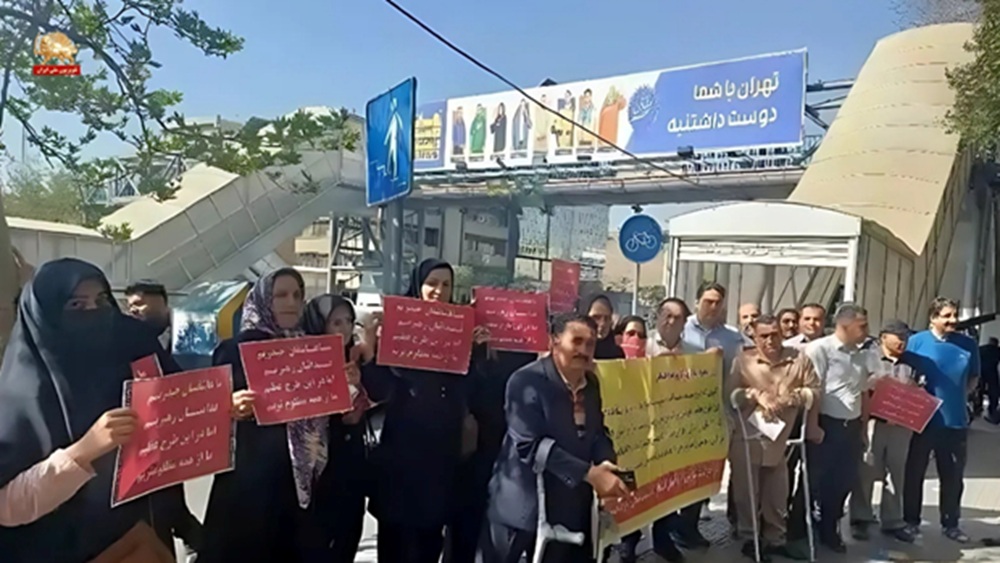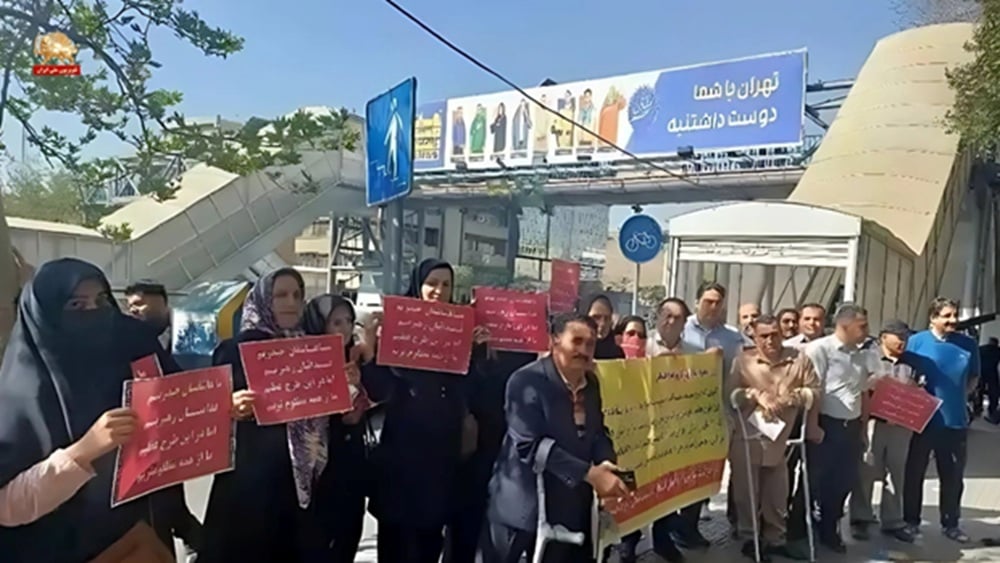Facebook
Twitter
LinkedIn
Pinterest
Reddit
Email
Print
 Employees of the Saham-e Edalat state-run financial organization hold protest rally (September 14, 2025)
Employees of the Saham-e Edalat state-run financial organization hold protest rally (September 14, 2025)
A new wave of protests swept across Iran on September 13 and 14, stretching from the resource-rich but impoverished southern provinces of Khuzestan and Baluchistan to the capital, Tehran. Diverse segments of Iranian society—including retirees, industrial workers, educated youth, and residents of marginalized regions—took to the streets in a unified display of anger against the clerical regime’s systemic corruption, economic ruin, and political oppression. These are not isolated grievances but a nationwide indictment of a ruling theocracy that has pushed its people to the brink.
The Betrayed Generation: Retirees and Workers Demand Their Rights
The protests powerfully featured the voices of those who have spent their lives building the country, only to be abandoned in their old age. In Ahvaz, the capital of Khuzestan province, social security retirees gathered to chant a slogan that cuts to the heart of the regime’s hypocrisy: “Hussain, Hussain is their slogan; lies and theft are their business!” a reference to the regime’s constant use of religion as a cover for its corrupt practices. This sentiment was echoed in the nearby city of Shush, where retirees protested crippling inflation and a lack of medical care, declaring, “We will not live under tyranny!”
September 14—Shush, southwest Iran
Retirees of the Social Security Organization protest crushing high prices, rampant inflation, meager wages, and lack of medical and healthcare services.
The retirees emphasized that they will not back down until they obtain their rights.… pic.twitter.com/kzniY6bAP5
— People’s Mojahedin Organization of Iran (PMOI/MEK) (@Mojahedineng) September 14, 2025
In Isfahan, retired steel workers marched with banners, holding the government directly responsible for their plight with chants of “Bankrupt government, enemy of the retiree!” and “Neither parliament nor government thinks of the nation!” This direct challenge to the state’s authority was mirrored by active workers. At the National Steel Group in Ahvaz, laborers protested months of unpaid wages and demanded the removal of corrupt managers, warning that mismanagement was driving the vital company toward collapse.
Marginalized Regions Rise Up
The regime’s policies of deliberate neglect in ethnic minority regions have ignited fierce resistance. In Rig Malek, a deprived area in Sistan and Baluchistan province, residents blocked a major road for the second consecutive night on September 13. Their protest was a direct response to border closures imposed by the state, a policy that has destroyed local livelihoods and exacerbated extreme poverty and unemployment in the region.
September 13—Mirjaveh, southeast Iran#IranProtests
Residents of Rig Malek district in Mirjaveh County blocked the main road for the second consecutive day by burning tires.
They protested the border policies of the IRGC and the provincial governor’s office.
Agriculture has been… pic.twitter.com/KMPyJesfCJ
— People’s Mojahedin Organization of Iran (PMOI/MEK) (@Mojahedineng) September 13, 2025
This sense of systemic discrimination was also palpable in Firuzabad, where villagers protested against the hiring practices of state-affiliated oil, gas, and steel plants. A local protester explained that these massive industrial operations not only pollute their land without accountability but also refuse to hire local talent, instead bringing in non-native workers. “Unemployment among our educated youth has led to a rise in addiction and social decay,” he stated, “but our voices are not heard.” The protests highlight a reality where the regime plunders regional resources while systematically impoverishing the local populations.
Educated Youth and Professionals Protest Systemic Corruption
In Tehran, the protests revealed a deep-seated frustration among Iran’s educated and professional classes, who see their futures being stolen by institutionalized corruption. On September 14, employees of the state’s “Justice Shares” program gathered from at least 20 different provinces to protest in front of the Ministry of Labor. Many of these workers, who include disabled individuals and educated female heads of household, have been kept in a state of employment uncertainty for 19 years and have not been paid their wages or insurance premiums for the last 27 months.
September 14—Tehran, Iran
A group of employees of Saham-e Edalat (Justice Shares), one of the largest financial programs of the regime, rally in front of the Ministry of Labor, protesting unclear job status and unpaid wages.#IranProtests pic.twitter.com/WRrnSDmNNB
— People’s Mojahedin Organization of Iran (PMOI/MEK) (@Mojahedineng) September 14, 2025
Simultaneously, a crowd of aspiring teachers rallied outside the Supreme Court and the National Inspectorate to protest the fraudulent results of the Education Ministry’s hiring exam. Out of 500,000 applicants, 490,000 were rejected. Protesters pointed out that top candidates with scores as high as 80% failed, while individuals with scores below 20% were accepted due to nepotism and manipulative “bonus points” for marital status or prior connections. The protests exposed the system as a “theatrical display of justice” designed to reward loyalty over merit. Further protests by kindergarten managers outside parliament against a new policy threatening their small businesses underscored how no sector is safe from the regime’s destructive decision-making.
The breadth and diversity of these protests paint an undeniable picture of a nation united against a common oppressor. From retired workers demanding their pensions to young graduates demanding a future, the message is the same: the clerical regime is the source of Iran’s suffering.
